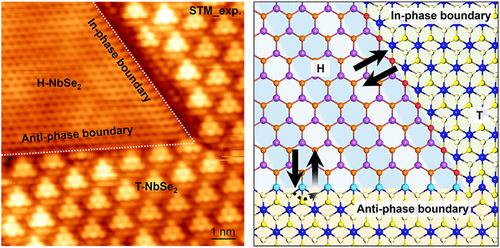Nanoscale Polymorph Engineering of Metal-Correlated Insulator Junctions in Monolayer NbSe2
IF 16
1区 材料科学
Q1 CHEMISTRY, MULTIDISCIPLINARY
引用次数: 0
Abstract
Lateral junctions composed of quantum many-body materials are highly desirable for realizing physical phenomena and device concepts. However, controllable fabrication of high-quality junctions is challenging, which greatly hinders further exploration. Here, we successfully realize monolayer heterophase homojunctions of metallic H-NbSe2 and correlated insulating T-NbSe2 with atomically sharp boundaries via nanoscale polymorph engineering. By applying a scanning tunneling microscopy (STM) tip pulse, T-NbSe2 can be locally introduced from H-NbSe2 on the side beneath the tip, thus realizing H/T-NbSe2 heterophase homojunctions. Our in situ STM measurements, complementary by the theoretical calculations, reveal two types of atomically sharp boundaries with distinct abilities for electron transmission, owing to the structure-dependent boundary coupling effects. Moreover, there are significant electronic interactions among the metallic, correlated insulating, and charge-density-wave states at the H/T-NbSe2 boundaries. Our results provide insight into the interacting mechanism among diverse quantum many-body states.

单层NbSe2中金属相关绝缘体结的纳米多晶工程
由量子多体材料组成的横向结对于实现物理现象和器件概念是非常理想的。然而,高质量结的可控制造具有挑战性,这极大地阻碍了进一步的探索。本文通过纳米多晶工程技术,成功地实现了金属H-NbSe2的单层异相同质结和相关的具有原子锐边界的绝缘T-NbSe2。通过扫描隧道显微镜(STM)尖端脉冲,T-NbSe2可以从尖端下方的H- nbse2局部引入,从而实现H/T-NbSe2异相同质结。我们的原位STM测量,与理论计算相辅相成,揭示了两种类型的原子尖锐边界,由于结构依赖的边界耦合效应,具有不同的电子传输能力。此外,在H/T-NbSe2边界处,金属态、相关绝缘态和电荷密度波态之间存在显著的电子相互作用。我们的研究结果揭示了不同量子多体态之间的相互作用机制。
本文章由计算机程序翻译,如有差异,请以英文原文为准。
求助全文
约1分钟内获得全文
求助全文
来源期刊

ACS Nano
工程技术-材料科学:综合
CiteScore
26.00
自引率
4.10%
发文量
1627
审稿时长
1.7 months
期刊介绍:
ACS Nano, published monthly, serves as an international forum for comprehensive articles on nanoscience and nanotechnology research at the intersections of chemistry, biology, materials science, physics, and engineering. The journal fosters communication among scientists in these communities, facilitating collaboration, new research opportunities, and advancements through discoveries. ACS Nano covers synthesis, assembly, characterization, theory, and simulation of nanostructures, nanobiotechnology, nanofabrication, methods and tools for nanoscience and nanotechnology, and self- and directed-assembly. Alongside original research articles, it offers thorough reviews, perspectives on cutting-edge research, and discussions envisioning the future of nanoscience and nanotechnology.
 求助内容:
求助内容: 应助结果提醒方式:
应助结果提醒方式:


